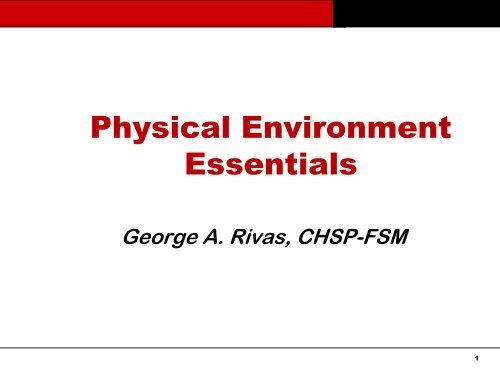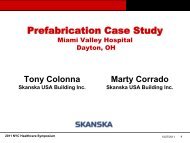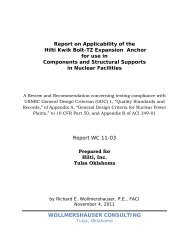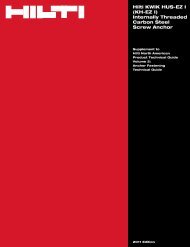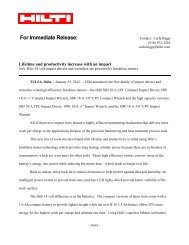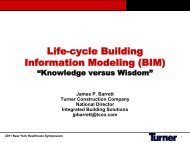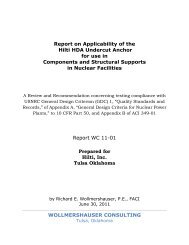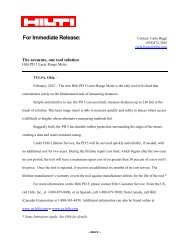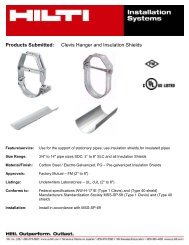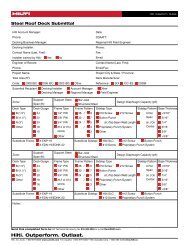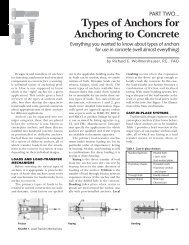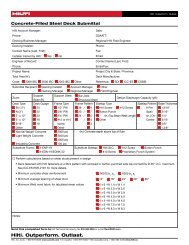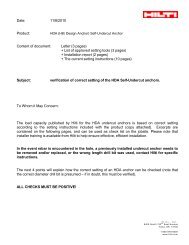TSIG Overview and Inspections - Hilti
TSIG Overview and Inspections - Hilti
TSIG Overview and Inspections - Hilti
Create successful ePaper yourself
Turn your PDF publications into a flip-book with our unique Google optimized e-Paper software.
Physical Environment<br />
Essentials<br />
George A. Rivas, CHSP-FSM<br />
2011 NYC Healthcare Symposium<br />
10/27/2011<br />
1
Scoring changes that took effect in 2009<br />
• No more supplemental recommendations<br />
• Introduction of direct & indirect impact scores<br />
• Added “documentation” expectations<br />
2011 NYC Healthcare Symposium<br />
10/27/2011<br />
2
2011-12 Changes?<br />
WHAT HAVE YOU HEARD?<br />
2011 NYC Healthcare Symposium<br />
10/27/2011<br />
3
So What’s New for 2011 - 12?<br />
• Fewer C Category Scores for Elements of Performance<br />
• Greater Emphasis on Life Safety<br />
• - Added Days for Life Safety Surveyor<br />
• - Additional LS Surveyors Hired & Trained<br />
• - LS Surveyors Auditing the EC EP’s<br />
2011 NYC Healthcare Symposium<br />
10/27/2011<br />
4
Life Safety Code Recommendations For<br />
Improvement’s (RFI’s) Remain Consistently within the<br />
Most Frequently Cited RFI’s (Top 10 in 2008, 2009 &<br />
2010)<br />
2011 NYC Healthcare Symposium<br />
10/27/2011<br />
5
• LS.02.01.20 (45%) The hospital maintains the<br />
integrity of the means of egress.<br />
• LS.02.01.10 (43%) Building <strong>and</strong> fire protection<br />
features are designed <strong>and</strong> maintained to minimize the<br />
effects of fire, smoke, <strong>and</strong> heat.<br />
• LS.02.01.30 (36%) The hospital provides <strong>and</strong><br />
maintains building features to protect individuals from<br />
the hazards of fire <strong>and</strong> smoke.<br />
2011 NYC Healthcare Symposium<br />
10/27/2011<br />
6
• 2010<br />
• PRELIMINARY ACCREDITATION<br />
• ACCREDITED<br />
• PROVISIONAL ACCREDITATION<br />
• CONDITIONAL ACCREDITATION<br />
• PRELIMINARY DENIAL OF ACCREDITATION<br />
• DENIAL OF ACCREDITATION<br />
• 2011<br />
• PRELIMINARY ACCREDITATION<br />
• ACCREDITED<br />
• ACCREDITED WITH FOLLOW UP SURVEY<br />
• - Requires Follow Up Survey usually within 30 days to 6<br />
• months<br />
• CONTINGENT ACCREDITATION<br />
• - Requires Follow Up Survey in 30 days<br />
• PRELIMINARY DENIAL OF ACCREDITATION<br />
• DENIAL OF ACCREDITATION<br />
2011 NYC Healthcare Symposium<br />
10/27/2011<br />
7
Criticality<br />
• The levels of criticality fall into four categories:<br />
1. Immediate Threat to Life<br />
2. Situational Decision Rules<br />
3. Direct Impact Requirements<br />
4. Indirect Impact Requirements<br />
2011 NYC Healthcare Symposium<br />
10/27/2011<br />
8
2011 NYC Healthcare Symposium<br />
10/27/2011<br />
9
Accreditation Based on Impact on Patient<br />
Care<br />
Immediacy of risk to patient<br />
care <strong>and</strong> the<br />
organization’s<br />
accreditation status<br />
Higher<br />
“Sharp End”<br />
Immediate<br />
Threat To Life<br />
(PDA until resolved)<br />
Situational<br />
Decision Rules<br />
(Conditional Accreditation <strong>and</strong><br />
Preliminary Denial of Accreditation )<br />
Timeline for resolution of noncompliant<br />
findings<br />
Shorter<br />
= Resolution/<br />
Validation<br />
Direct Impact Requirements<br />
“Implementation” Based Requirements<br />
(Short Resolution Timeframe)<br />
= Resolve in 45<br />
Days<br />
(PFI Acceptable)<br />
Lower<br />
Indirect Impact Requirements<br />
“Planning” <strong>and</strong> “Evaluation” Based Requirements<br />
(Longer Resolution Timeframe)<br />
= Resolve in 60 Days<br />
(PFI Acceptable)<br />
Longer<br />
2011 NYC Healthcare Symposium<br />
“Blunt End”<br />
10/27/2011<br />
10
• A indicates scoring all or nothing<br />
• C indicates scoring based on >90% of sampling<br />
• 2 indicates situational rules apply<br />
• 3 indicates direct impact requirements apply<br />
• M indicates Measure of Success<br />
• D indicates documentation is required<br />
2011 NYC Healthcare Symposium<br />
10/27/2011<br />
11
2011 NYC Healthcare Symposium<br />
10/27/2011<br />
12
Emphasis of Current EC Surveys<br />
• Focus on integration of Life Safety & Emergency Management<br />
*Independent Chapters began in 2009<br />
• Use of Tracer process to validate how EC processes work<br />
• Living up to your management plans<br />
• Documentation of risk assessment is critical<br />
• Staff behavior is under constant watch<br />
2011 NYC Healthcare Symposium<br />
10/27/2011<br />
13
Goal 2 Improve communication<br />
among caregivers.<br />
58%<br />
Goal 8 Accurately <strong>and</strong> completely<br />
reconcile medications<br />
46%<br />
MM.2.20 Medications are properly<br />
<strong>and</strong> safely stored.<br />
44%<br />
UP 1 Fulfill expectations set forth in<br />
the Universal Protocol.<br />
30%<br />
EC.5.20 Environment designed &<br />
maintained to comply with NFPA 101<br />
26%<br />
MM.3.20 Medication orders written<br />
clear & transcribed accurately.<br />
26%<br />
PC.8.10 Pain is assessed in all<br />
patients.<br />
19%<br />
IM.6.10 Complete & accurate<br />
medical record for patients<br />
18%<br />
EC.1.10 The hospital manages<br />
safety risks.<br />
17%<br />
Goal 3 Improve the safety of using<br />
medications.<br />
17%<br />
0% 10% 20% 30% 40% 50% 60% 70%<br />
2011 NYC Healthcare Symposium<br />
10/27/2011<br />
14
Life Safety Planning & Implementation<br />
• Compliance with NFPA Life Safety Code 101 2000<br />
edition<br />
• Comply with NFPA 101, 2000 edition or,<br />
• Obtain & equivalency or approved PFI<br />
• Maintain a current Statement of Conditions<br />
2011 NYC Healthcare Symposium<br />
10/27/2011<br />
15
Life Safety Planning & Implementation<br />
• Statement of Conditions<br />
• SOC requirements (required buildings)<br />
• Accurate assessment & correction plans<br />
• Necessity of keeping SOC current<br />
• BMP alternatives<br />
• Qualifications<br />
2011 NYC Healthcare Symposium<br />
10/27/2011<br />
16
Life Safety Code Recommendations For<br />
Improvement’s (RFI’s) Remain Consistently<br />
within the Most Frequently Cited RFI’s (Top 10<br />
in 2008, 2009 & 2010)<br />
2011 NYC Healthcare Symposium<br />
10/27/2011<br />
17
CMS Survey Results<br />
• Nearly x 5-10 times the Number of RFI’s<br />
uncovered, compared to TJC Surveys!<br />
• DNV: too early to tell<br />
2011 NYC Healthcare Symposium<br />
10/27/2011<br />
18
Life Safety Requires:<br />
• A diligent, ongoing process for monitoring,<br />
surveying <strong>and</strong> repair<br />
• Someone with a knowledge of the NFPA 101 Life<br />
Safety Code<br />
• A sound, rational <strong>and</strong> realistic approach for<br />
alternatives <strong>and</strong> interim measures<br />
2011 NYC Healthcare Symposium<br />
10/27/2011<br />
19
STEP ONE<br />
• Identify the deficiency!<br />
• Ignorance of the code is not an excuse<br />
• When in doubt, consider it a deficiency<br />
• And then seek the answer<br />
• Multiple resources include:<br />
• TJC St<strong>and</strong>ards (LS Chapter)<br />
• NFPA Membership<br />
• Ask a Consultant<br />
• rivasg@tsigconsulting.com (847) 612-8424<br />
2011 NYC Healthcare Symposium<br />
10/27/2011<br />
20
STEP TWO<br />
• TJC Provides the Following Options<br />
• Option #1 - Resolve the deficiency immediately with<br />
documentation.<br />
• Option #2 - A documented management process identifying<br />
the deficiency, actions to resolve the deficiency, date<br />
observed <strong>and</strong> date corrected. This process is permitted for<br />
deficiencies that can be resolved in 45 days. *** (documented<br />
+/- 90 days & Code ref)<br />
2011 NYC Healthcare Symposium<br />
10/27/2011<br />
21
STEP TWO<br />
• Option #3- A Plan for Improvement (PFI) which is<br />
located in the Statement of Conditions (SOC). This<br />
process is used for deficiencies identified in the<br />
Life Safety Chapter that require more than 45 days<br />
to resolve. This process also includes the<br />
implementation of ILSM’s (Interim Life Safety<br />
Measures) as per the organizations policy.<br />
2011 NYC Healthcare Symposium<br />
10/27/2011<br />
22
STEP TWO<br />
• Option #4 – A Life Safety Equivalency approved by<br />
The Joint Commission. To protect occupants<br />
during submittal process, deficiencies <strong>and</strong> ILSM’s<br />
implemented per organization policy must be<br />
documented.<br />
2011 NYC Healthcare Symposium<br />
10/27/2011<br />
23
Option #3<br />
• What is the SOC?<br />
• A Documented (electronic) Record of Life Safety Code<br />
Deficiencies for each building, defining:<br />
• The specific deficiency & location *LSC related<br />
• The date identified<br />
• The corrective action<br />
• The approximate cost for repair<br />
• The allocation of funding<br />
• The projected completion date*<br />
• The above are the “Plan for Improvement” (PFI)<br />
2011 NYC Healthcare Symposium<br />
10/27/2011<br />
24
Option #3<br />
• What Buildings can we use the SOC for?<br />
• Healthcare occupancies (including LTC)<br />
• Ambulatory occupancies<br />
• NOT business occupancies!<br />
• Ensure you identify who is responsible for maintaining the SOC<br />
• Identify the qualifications for those who prepare the SOC<br />
• Must have current <strong>and</strong> updated Life Safety Drawings*<br />
2011 NYC Healthcare Symposium<br />
10/27/2011<br />
25
2011 NYC Healthcare Symposium<br />
10/27/2011<br />
26
Option #3<br />
• Entering a plan for improvement is solely not<br />
enough.<br />
• You must assess Interim Life Safety Measures (ILSM)<br />
• Assess the risk of each PFI or group like issues<br />
• Determine the measures that are the most rational <strong>and</strong><br />
practical, as related to each PFI<br />
• Failure to do so will result in serious adverse consequence!<br />
2011 NYC Healthcare Symposium<br />
10/27/2011<br />
27
Option #3<br />
• What is ILSM? LS.01.02.01 EP 1-14<br />
• Administrative controls to create a fire-safe<br />
balance for the current deficiencies defined<br />
• Must have written Policy & Procedure<br />
*The policy includes criteria for evaluating when <strong>and</strong> to what extent the hospital follows special<br />
measures to compensate for increased life safety risk<br />
• Must have completed assessment<br />
documentation, indicating measures deemed<br />
necessary.<br />
• ILSM is an ongoing assessment process (things<br />
change)<br />
2011 NYC Healthcare Symposium<br />
10/27/2011<br />
28
• Interim Life Safety Measures (ILSM)<br />
• Assess each deficiency<br />
• Select appropriate measures (if any)<br />
• Implement selected measures<br />
• Document implementation of measures<br />
• Monitor program effectiveness<br />
2011 NYC Healthcare Symposium<br />
10/27/2011<br />
29
2011 NYC Healthcare Symposium<br />
10/27/2011<br />
30
2011 NYC Healthcare Symposium<br />
10/27/2011<br />
31
Option #3<br />
• Be careful when defining your ILSM measures<br />
• Are you capable of living up to your own expectations?<br />
• Does the temporary balancing measure(s) truly fit the<br />
deficiency?<br />
• Are you monitoring <strong>and</strong> adjusting measures?<br />
2011 NYC Healthcare Symposium<br />
10/27/2011<br />
32
Option #4<br />
• There are Two Types of Equivalencies:<br />
• The Traditional Equivalency<br />
• The Fire Safety Evaluation System (FSES) –<br />
NFPA 101A (2001 Edition)<br />
2011 NYC Healthcare Symposium<br />
10/27/2011<br />
33
Option #4<br />
• Traditional Equivalency includes:<br />
• Defining the deficiency in detail<br />
• Providing a rational defense as to why the<br />
equivalency should be approved<br />
• This includes taking into account all other safe-guard<br />
measures in place including ILSM<br />
• Must be submitted electronically via your TJC eSOC<br />
web access site<br />
• Limited to acceptance only by TJC, NOT CMS!<br />
2011 NYC Healthcare Symposium<br />
10/27/2011<br />
34
Option #4<br />
• FSES<br />
• FSES may be used when prescriptive compliance<br />
cannot be achieved<br />
• The FSES is based on a point system<br />
• Not typically accepted for new construction<br />
• Accepted by all regulatory accreditation agencies<br />
(provided scores align in your favor <strong>and</strong> completed<br />
correctly)<br />
• Requires preparer to be very knowledgeable of<br />
NFPA <strong>and</strong> 101A<br />
• Must be resubmitted <strong>and</strong> approved annually for<br />
CMS<br />
2011 NYC Healthcare Symposium<br />
10/27/2011<br />
35
WHICH OPTION TO CHOOSE?<br />
• It’s up to the organization to determine what<br />
works best but ask this question:<br />
• Can we live up to the dem<strong>and</strong> of our choice?<br />
• Timeliness<br />
• Effort<br />
• Cost<br />
• What if?<br />
2011 NYC Healthcare Symposium<br />
10/27/2011<br />
36
Questions<br />
Thank you for your time!<br />
George A. Rivas, CHSP-FSM<br />
<strong>TSIG</strong> Consulting rivasg@.tsigconsulting.com<br />
740 Broadway 847-612-8424<br />
10 th Floor<br />
New York, NY 10003<br />
2011 NYC Healthcare Symposium<br />
10/27/2011<br />
37


